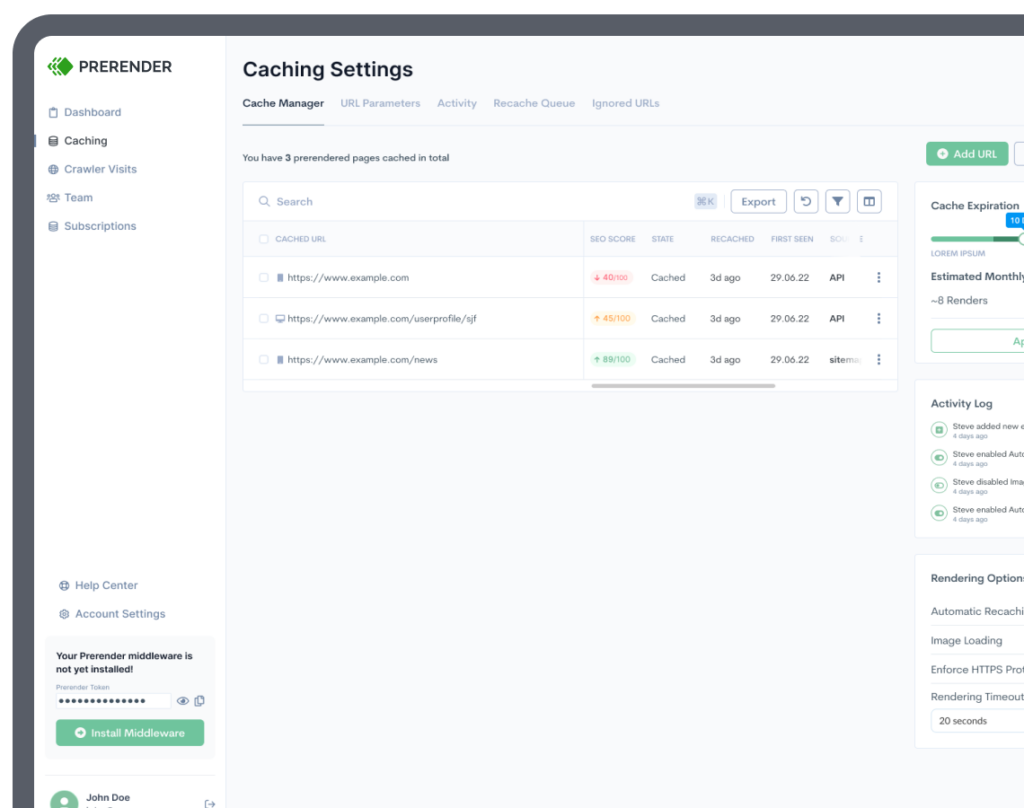Today’s ecommerce competition is tough. If you don’t maintain your ecommerce SEO performance, reaching the top SERP rankings and getting organic sales will be difficult.
We’ve seen it a lot as many website owners and SEO professionals prioritize optimizing the on-page and off-page SEO and neglect the technical SEO aspects due to its complexity. This isn’t ideal, as technical SEO is an integral ranking factor. So, to alleviate some of the burden, we’ve compiled a checklist on how to improve your technical SEO health.
This guide covers various aspects such as an seo checklist for ecommerce website, mobile optimization, setting up the XML sitemap, and increasing PageSpeed. Following this checklist can help you boost your online store’s visibility and performance.
Without further ado, let’s dive right in.
What Makes Ecommerce Websites Liable to Technical SEO Problems?
Ecommerce websites are famous for the following characteristics:
- Containing a large volume of pages
- Hosting dynamic content (e.g., regular changes in product availability, prices, and promotions)
- Complex URL structures (multiple categories and subcategories)
- Various product variations and filters (liable to duplicate content issues)
- Image-heavy content (e.g., product and review photos)
These unique traits make ecommerce websites prone to technical SEO problems. Let’s take the giant online store Amazon as an example.
Amazon prioritizes aligning its products’ SEO components with users’ search queries. By doing so, Google places their product listings at the top of search results, increasing the likelihood of purchases. This notion extends to product updates as well. Amazon needs to guarantee that the SEO and product changes are readable to search engine bots so that users will see the latest version of the product.
The above example only illustrates changes made to one product. Now, multiply that by hundreds of thousands of product pages … you can see how ecommerce websites are vulnerable to SEO issues.
Implementing what Amazon does demands a lot of resources, such as a sizable crawl budget and robust servers. Fortunately, you can apply some practical technical SEO methods to reduce the required resources. The following list outlines these methods.
Related: Learn more about crawl budget optimization in this white paper.
5 Must-Have Technical SEO Elements to Improve Website Visibility
1. Mobile Optimization
According to Statista, 59% of all internet traffic in Q1 2023 came from a mobile device. And it’s not just humans who love the mobile-first approach; search engines do, too.
In 2016, Google announced that they predominantly use the mobile version of a site’s content for indexing and ranking websites through mobile-first indexing.
Related: Learn about how Google’s mobile-first indexing challenges and opportunities.
How does this affect an ecommerce website?
With the increasing number of people doing mobile shopping, it’s important to guarantee that your website is optimized for mobile use. This can be done by focusing on these areas:
- Create a mobile-friendly design: for example, content is easily readable (adequate font size and type), and the website elements are adequate size (e.g., buttons and images).
- Create a responsive design: for example, all buttons are working with quick response, and the close button on pop-up windows is visible.
By optimizing your website for mobile, you do two things at once: increase your SERP rankings and provide a seamless shopping experience for your customers. Additionally, as voice search becomes increasingly popular, mobile content optimization can help users find their queries accurately. This is particularly helpful for local businesses as mobile voice searches are three times more likely to be for something local when compared to text searches.
2. XML Sitemap
An XML sitemap is a file that lists all the URLs (webpage addresses) of a website in a structured format, typically in XML (extensible markup language). This file is aimed to help search engines understand the organization of a website so they can index the pages more efficiently.
Since ecommerce websites usually have a lot of pages and complex navigation, it’s very easy for some pages to be buried, preventing search engine bots from finding and crawling them. Consequently, they won’t get indexed, resulting in nothing to your bottom line.
XML sitemaps provide a direct solution to this by offering bots a clear path to reach your pages. You can also prioritize important pages and additional metadata to each page.
You can create a sitemap using a sitemap generator tool or manually. Here’s an example of what an XML sitemap looks like.
<?xml version="1.0" encoding="UTF-8"?>
<urlset xmlns="http://www.sitemaps.org/schemas/sitemap/0.9">
<url>
<loc>https://www.yourwebsite.com/</loc> <!-- URL of your homepage -->
<lastmod>2023-10-11T08:00:00+00:00</lastmod> <!-- Last modification date in ISO 8601 format -->
<changefreq>daily</changefreq> <!-- How frequently the page is likely to change (e.g., hourly, daily, weekly, monthly) -->
<priority>1.0</priority> <!-- Priority of the page, typically between 0.0 and 1.0 -->
</url>
<url>
<loc>https://www.yourwebsite.com/about</loc> <!-- URL of your 'About' page -->
<lastmod>2023-10-10T14:30:00+00:00</lastmod>
<changefreq>weekly</changefreq>
<priority>0.8</priority>
</url>
<url>
<loc>https://www.yourwebsite.com/products/product-1</loc> <!-- URL of a product page -->
<lastmod>2023-10-09T10:15:00+00:00</lastmod>
<changefreq>monthly</changefreq>
<priority>0.9</priority>
</url>
</urlset>Here’s a breakdown of the elements used in the XML sitemap:
- <urlset>: the root element of the XML sitemap.
- <url>: each <url> element represents a URL on your website.
- <loc>: the URL of a specific page.
- <lastmod>: the date of the last modification of the page, formatted in ISO 8601 (Year-Month-DayTHour:Minute: Second+Timezone).
- <changefreq>: indicates how frequently the page is likely to change (e.g., daily, weekly, etc.).
- <priority>: assigns a priority to the page (typically between 0.0 and 1.0), indicating its relative importance compared to other pages.
Related: If you want to learn more about using sitemap to increase your technical SEO results, check out our blog on How to Guide Googlebot in Crawling Important URLs.
3. HTTPS and Security
When it comes to ecommerce SEO, ensuring the security of your website is paramount. One way to accomplish this is by implementing HTTPS. Encrypting the connection between your website and users will safeguard users’ sensitive information and provide a secure shopping experience.
Moreover, having a secure website is not only beneficial for user experience but also for SERP positions, as search engines prioritize secure websites in their rankings. Google even displays a “Not Secure” badge on websites without HTTPS implementation.
To implement HTTPS on a website, you need an SSL/TLS (secure sockets layer/transport layer security) certificate. This certificate is issued by a trusted Certificate Authority (CA) and contains encryption keys and details about the website.
Many web hosting providers offer SSL certificates as part of their hosting packages. After obtaining a certificate, you need to install it on your web server and configure your server to use HTTPS.
4. URL Structure
Having well-organized URL structures is often underrated, but it’s essential for effective ecommerce SEO.
Clean and organized URLs with descriptive keywords should be a priority in your on-page SEO checklist. They make it easier for users to navigate and share specific pages. Furthermore, having a logical website hierarchy can help search engines better understand your pages’ relationships and prioritize them accordingly in search results.
For an SEO-optimized URL structure, there are three things you must do:
- Employ lowercase letters and hyphens instead of spaces, and avoid using special characters
- Incorporate target keywords into the URLs
- Maintain concise, descriptive URLs closely related to the content
5. PageSpeed
PageSpeed is more than just a ranking factor. It also influences your bounce rates, conversion rates, and crawling performance.
When a page takes longer than 3 seconds to load, 40% of desktop users will bounce, and 53% of mobile users will leave the page. As for the crawling rates, when your pages are slow to load, search engines can deprioritize your sites from being crawled. And as we all know, a page must be crawled and indexed before appearing on the SERPs. Without proper crawling and indexation, your page could land at the bottom of the SERP rankings months later.
To optimize your site speed, most websites implement caching and other JavaScript SEO techniques, such as Prerender. Prerender solves the JavaScript SEO and PageSpeed bottlenecks by serving search engines a ready-to-index snapshot of your page. Sign up to see your ecommerce SEO improved within weeks!
Once a request is sent from a crawler, Prerender fetches the page, renders it, and stores it in the cache. This way, whenever bots request the page, Prerender will feed them the 100% rendered version, speeding up the indexing process.
Consequently, your pages will be quickly and perfectly indexed, eliminating common JavaScript SEO issues like missing content. And since PageSpeed is now improved, so do your Core Web Vitals scores. All these technical SEO improvements will help boost your ecommerce SEO health and land your page at the top of SERP rankings.
Technical SEO Improvements Boost SERP Rankings
Now you know how to optimize your technical SEO for better rankings armed with seo checklist for ecommerce website. By focusing on the above-mentioned factors, you can improve your website’s visibility, attract organic traffic, and drive more sales.
Remember, technical SEO is an ongoing process. It’s important to regularly monitor and update your website, so you can maintain a strong presence at the top of SERPs.
FAQs on Technical SEO for Ecommerce Websites
1.) What are some common technical SEO issues on ecommerce websites?
Some common technical SEO issues on ecommerce websites are:
- Slow PageSpeed
- Lack of mobile optimization
- No XML sitemap
- Poor site architecture
2.) Why is technical SEO important for ecommerce websites?
Poor technical SEO has a significant negative impact on ecommerce websites since they typically:
- Have a large number of pages – causing indexation issues and poor rankings
- Are in a competitive landscape – if users can’t find your brand, it’s difficult to initiate sales
- Depend on conversion rates – low PageSpeed results in high bounce rates and low conversion rate
Because of this, regular monitoring and optimization of technical SEO elements is required to maintain high-performing ecommerce websites.
3.) Why are ecommerce websites prone to poor indexing and page load time?
Retail websites are famous for having slow crawling and PageSpeed due to the multi-faceted and ever-changing inventory. This unique situation makes search engine bots struggle to index the pages and keep up with page updates.
To overcome this issue, adopt Prerender. We render the pages in advance and feed them to the bots when requested, improving your PageSpeed substantially. And whenever you update a page, you can ask Prerender to recache it to ensure both users and bots can access the latest version.



